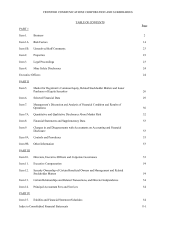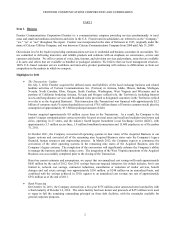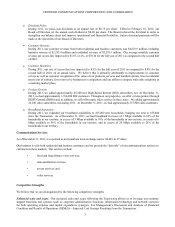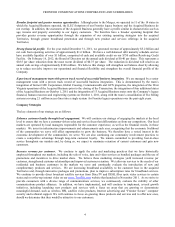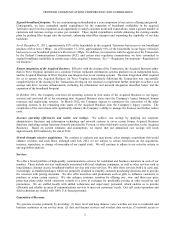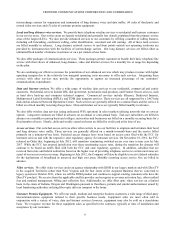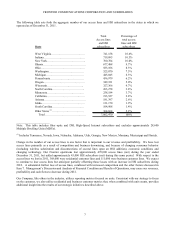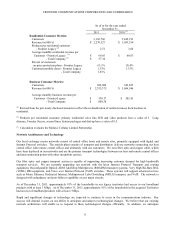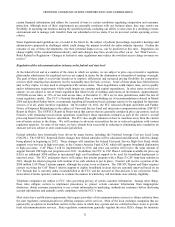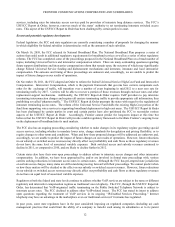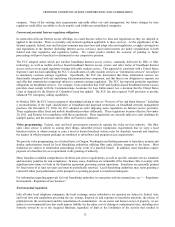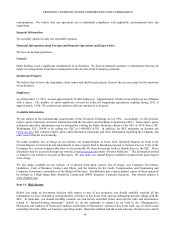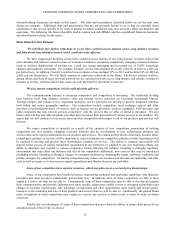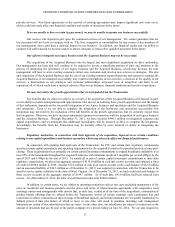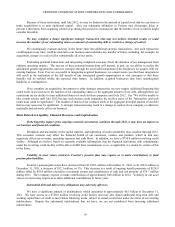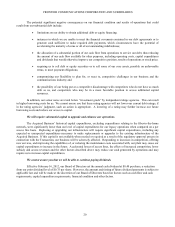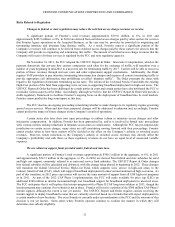Frontier Communications 2011 Annual Report Download - page 14
Download and view the complete annual report
Please find page 14 of the 2011 Frontier Communications annual report below. You can navigate through the pages in the report by either clicking on the pages listed below, or by using the keyword search tool below to find specific information within the annual report.FRONTIER COMMUNICATIONS CORPORATION AND SUBSIDIARIES
11
certain financial information and adhere for a period of time to certain conditions regulating competition and consumer
protection. Although most of these requirements are generally consistent with our business plans, they may restrict our
flexibility in operating our business during the specified periods, including our ability to raise rates in a declining revenue
environment and to manage cash transfers from our subsidiaries in two states if we do not meet certain operating service
criteria.
Some legislation and regulations are, or could in the future be, the subject of judicial proceedings, legislative hearings and
administrative proposals or challenges which could change the manner in which the entire industry operates. Neither the
outcome of any of these developments, nor their potential impact on us, can be predicted at this time. Regulation can
change rapidly in the communications industry, and such changes may have an adverse effect on us. See “Risk Factors—
Risks Related to Regulation—Changes in federal or state regulations may reduce the switched access charge revenues we
receive.”
Regulation of the telecommunications industry at the federal and state level
At the federal level and in a number of the states in which we operate, we are subject to price cap or incentive regulation
plans under which prices for regulated services are capped in return for the elimination or relaxation of earnings oversight.
The goal of these plans is to provide incentives to improve efficiencies and increased pricing flexibility for competitive
services while ensuring that customers receive reasonable rates for basic services. Some of these plans have limited terms
and, as they expire, we may need to renegotiate with various states. These negotiations could impact rates, service quality
and/or infrastructure requirements which could impact our earnings and capital expenditures. In other states in which we
operate, we are subject to rate of return regulation that limits levels of earnings and returns on investments. Approximately
1,858,000 access lines, or 35% of our total access lines, at December 31, 2011 are in state jurisdictions under the rate of
return regulatory model. The FCC’s National Broadband Plan, a non-binding set of recommendations released in March
2010 and described further below, recommends requiring all incumbent local exchange carriers to be regulated for interstate
services, if at all, under incentive regulation. On November 18, 2011, the FCC released a Report and Order and Further
Notice of Proposed Rulemaking on the subject of Universal Service Fund and intercarrier compensation reform (USF/ICC
Report & Order). The USF/ICC Report & Order stated that carriers that are generally considered price cap carriers, such as
Frontier, with remaining rate-of-return operations would have those operations included as part of the carrier’s overall
price-cap based Universal Service calculation. The FCC also sought comment on how to transition away from the current
rate-of-return system in the future. We will continue to advocate our position for no or reduced regulation with various
regulatory agencies. In some of our states, we have already been successful in reducing or eliminating price regulation on
end-user services subject to state commission jurisdiction.
Federal subsidies have historically been driven by many factors, including the National Average Cost per Local Loop
(NACPL). The USF/ICC Report & Order changes how federal subsidies will be calculated and disbursed, with this change
being phased in beginning in 2012. These changes will transition the federal Universal Service High-Cost Fund, which
supports voice services in high-cost areas, to the Connect America Fund (CAF), which will support broadband deployment
in high-cost areas. CAF Phase I will be implemented in 2012, and price cap carriers will receive the same amount of
support from all USF high-cost programs as in 2011. In addition, the FCC in CAF Phase I will make available for price cap
ILECs an additional $300 million in incremental high cost broadband support to be used for broadband deployment to
unserved areas. The FCC anticipates that it will replace this interim program with a Phase II CAF long-term solution in
2013, though the interim program will continue if no such solution is put in place. Frontier will receive a portion of the
$300 million CAF Phase I interim support, although the extent is not yet known. The USF/ICC Report and Order requires
carriers receiving the CAF Phase I interim support to deploy broadband in areas that are currently unserved based on an
FCC formula that is currently under reconsideration at the FCC and the outcome of that decision is not yet known. Some
states where Frontier operates continue to evaluate the manner in which they will determine state subsidy eligibility.
Telephone companies are subject to FCC rules governing privacy of certain customer information. Among other things,
these rules obligate carriers to implement procedures to: protect certain customer information from inappropriate
disclosure; obtain customer permission to use certain information in marketing; authenticate customers before disclosing
account information; and annually certify compliance with the FCC’s rules.
Most states have certification requirements that require providers of telecommunications services to obtain authority from
the state regulatory commission prior to offering common carrier services. Most of the local exchange companies that are
operated by us operate as incumbent carriers in the states in which they operate and are certified in those states to provide
local telecommunications services. State regulatory commissions generally regulate the rates ILECs charge for intrastate


